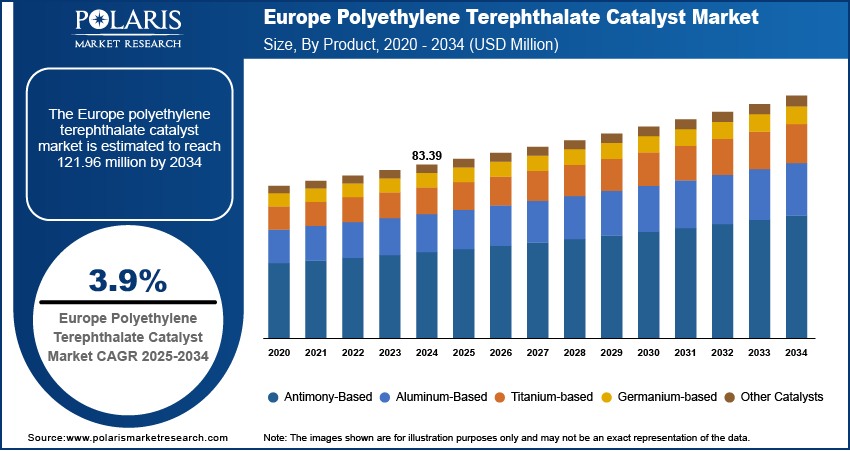The Europe polyethylene terephthalate (PET) catalyst market, valued at USD 83.39 million in 2024, is projected to grow at a compound annual growth rate (CAGR) of 3.9 % from 2025 to 2034.This strategic niche within the broader PET value chain continues to draw investor and corporate attention, owing to the accelerating mandates for recyclable plastics, supply-chain pressures, and evolving trade dynamics across regions. From a global perspective, upstream innovations and downstream adoption of catalysts are increasingly shaped by cross-border supply chains and regional manufacturing trends, making regional penetration strategies and geographic arbitrage more critical than ever.
In Europe, the catalyst market is tightly linked to the region’s strong regulatory push toward circular economy targets and stringent single-use plastic directives. Many European member states now require high collection and recycling quotas, pushing PET resin manufacturers toward catalysts that facilitate high rPET incorporation and improved polymerization efficiency. The regional manufacturing trend toward additive integration—localizing catalyst production closer to PET polymer plants—is gaining traction, thereby reducing reliance on imports and enhancing supply resilience within the EU. In contrast, North America has seen more flexible regulatory regimes but faces pressure from escalating feedstock costs and logistics constraints; U.S. and Mexican producers often import specialty catalysts from Asia or Europe, making trade tariffs and export licensing key levers. Meanwhile, in Asia Pacific, where PET consumption and recycling capacity growth dominate, catalyst makers are aggressively scaling local capacity and leveraging lower-cost raw materials; export-oriented plants in China, India and Southeast Asia serve both domestic PET polymer producers and external markets, amplifying the role of cross-border supply chains in arbitrage and margin allocation.
Turning to core market dynamics, the Drivers in Europe and globally include the intensifying focus on sustainable packaging, rising demand for lightweight PET bottles in food and beverage, and regulatory pressure pushing toward rPET utilization. In Europe especially, the adoption of strict recycling quotas (e.g. 77 % collection target by 2025 in EU states) forces PET resin makers to upgrade catalysts that can tolerate recycled feedstock and maintain product quality. The ability of advanced catalysts to reduce reaction times, lower energy consumption, and improve polymer clarity provides cost savings along the value chain. In North America, drivers additionally include rising downstream demand from booming beverage sectors and increasing domestic PET production, which feeds back into higher catalyst demand via forward integration.
By the same token, Restraints include raw material price volatility (antimony, titanium, germanium), occasional supply bottlenecks, and regulatory concerns over toxicity (especially for antimony-based catalysts). In Europe, regulatory scrutiny on heavy-metal leaching in food-contact PET constrains the share of certain catalysts. Trade barriers or export restrictions on catalyst precursors in countries like China or Russia can also disrupt cross-border supply chains, especially in import-reliant regions such as North America. In Asia, oversupply risk and margin erosion from aggressive pricing pose a restraint.
Read More @ https://www.polarismarketresearch.com/industry-analysis/europe-polyethylene-terephthalate-catalyst-market
Against this backdrop, Opportunities emerge in regional diversification and backward integration. European catalyst manufacturers can invest in capacity in Central and Eastern Europe to serve regional polymer hubs, reducing shipping costs and import duties. In North America, localized production of premium catalyst grades (antimony alternatives, hybrid systems) can reduce import dependence. In Asia Pacific, the opportunity lies in serving rising demand in emerging markets (e.g. Southeast Asia) and optimizing the value chain by sourcing catalyst feedstocks regionally. Moreover, joint ventures between European and Asian players create strategic footprint expansion and hedging across geopolitical risks. The push for green catalyst formulations (less toxicity, better recyclate compatibility) is another opening for differentiation and premium pricing.
Trends shaping the regional outlook include consolidation of the competitive landscape and niche specialization: leading firms are progressively deploying regional manufacturing footprints and targeting market penetration strategies in underserved locales. There is a discernible shift toward co-locating catalyst units near polymer plants, reflecting a trend toward vertical integration.
In Europe, the catalyst market is tightly linked to the region’s strong regulatory push toward circular economy targets and stringent single-use plastic directives. Many European member states now require high collection and recycling quotas, pushing PET resin manufacturers toward catalysts that facilitate high rPET incorporation and improved polymerization efficiency. The regional manufacturing trend toward additive integration—localizing catalyst production closer to PET polymer plants—is gaining traction, thereby reducing reliance on imports and enhancing supply resilience within the EU. In contrast, North America has seen more flexible regulatory regimes but faces pressure from escalating feedstock costs and logistics constraints; U.S. and Mexican producers often import specialty catalysts from Asia or Europe, making trade tariffs and export licensing key levers. Meanwhile, in Asia Pacific, where PET consumption and recycling capacity growth dominate, catalyst makers are aggressively scaling local capacity and leveraging lower-cost raw materials; export-oriented plants in China, India and Southeast Asia serve both domestic PET polymer producers and external markets, amplifying the role of cross-border supply chains in arbitrage and margin allocation.
Turning to core market dynamics, the Drivers in Europe and globally include the intensifying focus on sustainable packaging, rising demand for lightweight PET bottles in food and beverage, and regulatory pressure pushing toward rPET utilization. In Europe especially, the adoption of strict recycling quotas (e.g. 77 % collection target by 2025 in EU states) forces PET resin makers to upgrade catalysts that can tolerate recycled feedstock and maintain product quality. The ability of advanced catalysts to reduce reaction times, lower energy consumption, and improve polymer clarity provides cost savings along the value chain. In North America, drivers additionally include rising downstream demand from booming beverage sectors and increasing domestic PET production, which feeds back into higher catalyst demand via forward integration.
By the same token, Restraints include raw material price volatility (antimony, titanium, germanium), occasional supply bottlenecks, and regulatory concerns over toxicity (especially for antimony-based catalysts). In Europe, regulatory scrutiny on heavy-metal leaching in food-contact PET constrains the share of certain catalysts. Trade barriers or export restrictions on catalyst precursors in countries like China or Russia can also disrupt cross-border supply chains, especially in import-reliant regions such as North America. In Asia, oversupply risk and margin erosion from aggressive pricing pose a restraint.
Read More @ https://www.polarismarketresearch.com/industry-analysis/europe-polyethylene-terephthalate-catalyst-market
Against this backdrop, Opportunities emerge in regional diversification and backward integration. European catalyst manufacturers can invest in capacity in Central and Eastern Europe to serve regional polymer hubs, reducing shipping costs and import duties. In North America, localized production of premium catalyst grades (antimony alternatives, hybrid systems) can reduce import dependence. In Asia Pacific, the opportunity lies in serving rising demand in emerging markets (e.g. Southeast Asia) and optimizing the value chain by sourcing catalyst feedstocks regionally. Moreover, joint ventures between European and Asian players create strategic footprint expansion and hedging across geopolitical risks. The push for green catalyst formulations (less toxicity, better recyclate compatibility) is another opening for differentiation and premium pricing.
Trends shaping the regional outlook include consolidation of the competitive landscape and niche specialization: leading firms are progressively deploying regional manufacturing footprints and targeting market penetration strategies in underserved locales. There is a discernible shift toward co-locating catalyst units near polymer plants, reflecting a trend toward vertical integration.
The Europe polyethylene terephthalate (PET) catalyst market, valued at USD 83.39 million in 2024, is projected to grow at a compound annual growth rate (CAGR) of 3.9 % from 2025 to 2034.This strategic niche within the broader PET value chain continues to draw investor and corporate attention, owing to the accelerating mandates for recyclable plastics, supply-chain pressures, and evolving trade dynamics across regions. From a global perspective, upstream innovations and downstream adoption of catalysts are increasingly shaped by cross-border supply chains and regional manufacturing trends, making regional penetration strategies and geographic arbitrage more critical than ever.
In Europe, the catalyst market is tightly linked to the region’s strong regulatory push toward circular economy targets and stringent single-use plastic directives. Many European member states now require high collection and recycling quotas, pushing PET resin manufacturers toward catalysts that facilitate high rPET incorporation and improved polymerization efficiency. The regional manufacturing trend toward additive integration—localizing catalyst production closer to PET polymer plants—is gaining traction, thereby reducing reliance on imports and enhancing supply resilience within the EU. In contrast, North America has seen more flexible regulatory regimes but faces pressure from escalating feedstock costs and logistics constraints; U.S. and Mexican producers often import specialty catalysts from Asia or Europe, making trade tariffs and export licensing key levers. Meanwhile, in Asia Pacific, where PET consumption and recycling capacity growth dominate, catalyst makers are aggressively scaling local capacity and leveraging lower-cost raw materials; export-oriented plants in China, India and Southeast Asia serve both domestic PET polymer producers and external markets, amplifying the role of cross-border supply chains in arbitrage and margin allocation.
Turning to core market dynamics, the Drivers in Europe and globally include the intensifying focus on sustainable packaging, rising demand for lightweight PET bottles in food and beverage, and regulatory pressure pushing toward rPET utilization. In Europe especially, the adoption of strict recycling quotas (e.g. 77 % collection target by 2025 in EU states) forces PET resin makers to upgrade catalysts that can tolerate recycled feedstock and maintain product quality. The ability of advanced catalysts to reduce reaction times, lower energy consumption, and improve polymer clarity provides cost savings along the value chain. In North America, drivers additionally include rising downstream demand from booming beverage sectors and increasing domestic PET production, which feeds back into higher catalyst demand via forward integration.
By the same token, Restraints include raw material price volatility (antimony, titanium, germanium), occasional supply bottlenecks, and regulatory concerns over toxicity (especially for antimony-based catalysts). In Europe, regulatory scrutiny on heavy-metal leaching in food-contact PET constrains the share of certain catalysts. Trade barriers or export restrictions on catalyst precursors in countries like China or Russia can also disrupt cross-border supply chains, especially in import-reliant regions such as North America. In Asia, oversupply risk and margin erosion from aggressive pricing pose a restraint.
Read More @ https://www.polarismarketresearch.com/industry-analysis/europe-polyethylene-terephthalate-catalyst-market
Against this backdrop, Opportunities emerge in regional diversification and backward integration. European catalyst manufacturers can invest in capacity in Central and Eastern Europe to serve regional polymer hubs, reducing shipping costs and import duties. In North America, localized production of premium catalyst grades (antimony alternatives, hybrid systems) can reduce import dependence. In Asia Pacific, the opportunity lies in serving rising demand in emerging markets (e.g. Southeast Asia) and optimizing the value chain by sourcing catalyst feedstocks regionally. Moreover, joint ventures between European and Asian players create strategic footprint expansion and hedging across geopolitical risks. The push for green catalyst formulations (less toxicity, better recyclate compatibility) is another opening for differentiation and premium pricing.
Trends shaping the regional outlook include consolidation of the competitive landscape and niche specialization: leading firms are progressively deploying regional manufacturing footprints and targeting market penetration strategies in underserved locales. There is a discernible shift toward co-locating catalyst units near polymer plants, reflecting a trend toward vertical integration.
0 Comments
0 Shares
801 Views
0 Reviews


